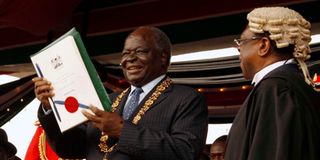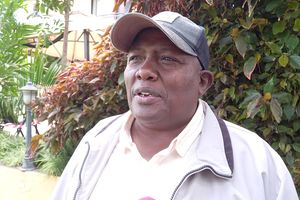Premium
Consensus gave us 2010 Constitution

President Mwai Kibaki displays a copy of the new Constitution after the promulgation ceremony at Uhuru Park, Nairobi on August 27, 2010. Looking on is then Attorney General Amos Wako.
What you need to know:
- As an MP in the 10th Parliament I directly participated in the political negotiations and intrigues around the crafting of the 2010 Constitution.
- Kenyans wanted to elect their president. So, how do you elect a president by popular vote if (s)he was going to have a ceremonial role?
History is often written in broad strokes, partially because it is difficult to reproduce it in minute detail in a short essay, article or book. This tends to gloss over the hiccups of human processes and paint a fairly romantic picture. And so it is with our written recollections of the processes that led to the Constitution of Kenya 2010.
A number of my friends and I served as members of the 10th Parliament and were, therefore, direct participants in the political negotiations and intrigues around the crafting of the Constitution.
Since the High Court judges delivered what an Indian writer has referred to as an instant classic, we have debated over many hours, jogging our memories on what happened during that momentous period from 2008 to 2010. Here are my personal recollections.
First, the citizens wanted to do away with an “imperial presidency”. Therefore, various experts and drafters said the citizens preferred a parliamentary system. The Committee of Experts’ draft and the Ghai draft before it proposed such a system of government. In a parliamentary system, the prime minister is the executive head of government, and (s)he gets this role by being the leader of the largest party or coalition of parties in parliament. The president’s role is the head of state, and is largely ceremonial.
But there was a big contradiction. Kenyans wanted to elect their president. So, how do you elect a president by popular vote if (s)he was going to have a ceremonial role?
One possible solution was for Parliament, acting as an electoral college, to elect the president. But most Kenyans wanted to elect their president directly. In the end it was a political, not legal nor expert negotiation.
Presidential system
Option three, a hybrid. PNU wanted a presidential system or at the very minimum, a hybrid. ODM wanted a pure parliamentary system. There was deep mistrust between the two teams. So we ended up with a presidential system.
The experts proposed devolution at 15 regions. Economists, such as myself, argued that these units of devolution needed to be large enough to have economic and financial viability.
As a result of political and not legal nor expert talks, we ended up with 47 counties, based on the districts that existed in 1992.
There was consideration to devolve basic education, as the child is generally with the parents in the formative years. However, the teachers’ unions, a strong constituency, did not want it to be devolved. A friend recalls the real reason for not devolving basic education was to avoid balkanisation.
The Committee of Experts’ draft had proposed the Senate as the upper House, but members of the National Assembly were not comfortable with another chamber that would be considered superior to theirs.
So, not all the decisions made to bring about the Constitution of Kenya 2010 were the result of careful expert consideration, and public participation. Many key decisions were compromises.
Ndiritu Muriithi is the governor of Laikipia County





